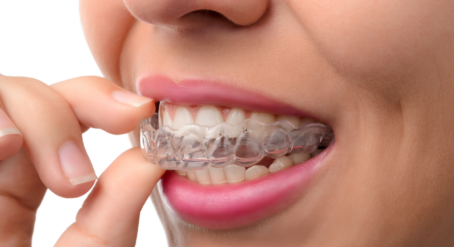While clear aligners are quickly becoming one of the most popular orthodontic treatments for adults, some orthodontists simply won’t suggest them as a solution for certain people.
Even though clear aligners are more convenient than other orthodontic treatments, it’s important that you understand the facts about this popular treatment before asking your orthodontist if it’s the right option for you.
What is clear aligner treatment?
Clear aligners are exactly what the name says – they’re clear plastic mouthguards that help align your teeth. Most people would know them by their brands names, such as Invisalign®, Spark® or 3M Clarity®. Undergoing a clear alignment treatment is often the same amount of time as other orthodontic treatments (usually 12–18 months), but it requires more commitment and might not fix underlying issues you may have, such as jaw or bite misalignment.
What are the positives of clear aligner treatment?
- They are much less noticeable when you wear them. This makes them an appealing option for those who want to subtly undergo an orthodontic treatment.
- They’re more comfortable and convenient to wear, as you can take them out when you eat, drink and clean your teeth.
- There are other health benefits from wearing clear aligners. You can maintain good oral health by brushing and flossing properly, as well as reducing the risk of gum irritation or allergies as they’re made from BPA-free, medical-grade plastic.
What are the negatives of clear aligner treatment?
- The cost of clear aligners can sometimes be more expensive than braces or other orthodontic treatments.
- Wearing clear aligners requires discipline, as you must wear them for about 20–22 hours every day. If you don’t wear them for the recommended time, you can put the success of your orthodontic treatment at risk.
- There are limitations on what tooth problems they can correct. So, if your orthodontist identifies that you have a more complex issue, then clear aligners alone may not be able to solve the problem.
- They are easy to misplace or damage if they’re not stored safely and properly when you eat, drink or brush your teeth. You would need to take more care not to lose your aligners or damage them, as this can be costly and delay your treatment.
Can an orthodontist offer clear aligner treatment?
Orthodontist can offer clear aligners as an effective orthodontic treatment for many adults. However, there some complex cases might require a combination of traditional orthodontic treatment and clear aligners to fix more significant tooth and jaw alignment issues. This decision will be at the discretion of your orthodontist.
Why your orthodontist may suggest you shouldn’t have clear aligners
While clear aligners seem like an easy option to fix minor teeth problems, there are three important factors as to why your orthodontist would recommend a different treatment for your specific tooth and jaw needs.
-
You have complex treatment needs
There are some issues that clear aligners simply can’t fix. And if you’re someone with complex teeth or jaw issues, then your orthodontist might recommend more traditional treatments. This is because clear aligners don’t move teeth in the same way as braces, and may not be able to correct jaw misalignment.
While clear aligners are good for many mild to moderate orthodontic concerns, if your orthodontist identifies that you have complex needs, they may recommend a different treatment option to achieve the best possible outcome.
-
You don’t have the right teeth shape or position
For clear aligners to work predictably, they must have a secure grip on the teeth. Very small or undersized teeth may be more challenging to treat with clear aligners due to the reduced surface area of the teeth for the aligner to grip.
Certain tooth movements are less predictable to manage with clear aligners. Closing large spaces, such as following the removal of a tooth, or bringing an impacted tooth into alignment may not be possible with clear aligner treatment alone. Your orthodontist will always discuss the relevant treatment options for your individual case and any limitations of these treatment options.
-
You’ve had previous dental work
If you’ve had a specific type of dental work done to your teeth previously, such as prosthetic dental implants, then the possibility of having orthodontic treatment is reduced, or limit the amount of orthodontic correction that is required.
Other dental prosthetics such as dental crowns and bridges may also be potential issues. Fortunately, your orthodontist can work with other dentists and specialists to ensure that you are aware of all relevant treatment options and what can be realistically achieved for your individual case.
Start your orthodontic journey
At the end of the day, your orthodontist will make the call on whether or not clear aligners are the right treatment option to suit your teeth and jaw alignment issues. But if you want to start your orthodontic journey, then check out our Finder Tool. You can search for a local orthodontist in your area and requestion a consultation, all in the one spot.









